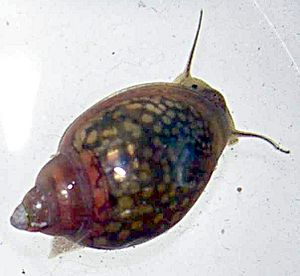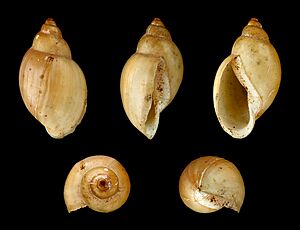European physa facts for kids
Quick facts for kids European physa |
|
|---|---|
 |
|
| A live individual of Physella acuta | |
| Scientific classification | |
| Genus: |
Physella
|
| Species: |
acuta
|
| Synonyms | |
|
Physa acuta Draparnaud, 1805 |
|
Physella acuta is a small, air-breathing freshwater snail. It is a type of gastropod mollusk that lives in water. This snail is special because its shell opens on the left side. This is called being "left-handed" or sinistral. Some common names for this snail are European physa, tadpole snail, and bladder snail.
Contents
Etymology
The name Physella has a bit of a mystery around it. It might come from an old Greek word. A French scientist named Jacques Philippe Raymond Draparnaud was the first person to describe a species from the Physella group. He also gave it its name.
Shell description
Snails in the Physidae family, like Physella acuta, have shells that are "left-handed" or sinistral. This means if you hold the shell with its opening facing you and the pointy top upwards, the opening will be on the left side.
The shells of Physella snails have a large opening. Their top part, called the spire, is pointed. They do not have a special lid, called an operculum, to close their shell. Their shells are thin, clear, and look a bit like horn.
Distribution
Scientists once thought that Physella acuta originally came only from the Mediterranean Basin. However, it is now known that its native home also includes North America. This is because some snails previously thought to be different species, like Physella heterostropha, are actually the same as Physella acuta.
Physella acuta is a very common snail. It can be found all over North America and Europe, including the United Kingdom. It seems to have first spread through warmer Mediterranean areas. Then, it slowly moved into Northern Europe. This snail has also been brought to New Zealand. There, it lives in ponds, lakes, and rivers on both islands.
In the United Kingdom
In the United Kingdom, Physella acuta is seen as an invasive species. This means it is not native to the area and can sometimes cause problems for local plants and animals. It is often called the "European Physa" or "common bladder snail" in England. This snail has become very common in many rivers and streams across England, Wales, Scotland, and Northern Ireland. This includes big rivers like the River Severn and the River Thames. Experts are still studying how this invasive snail affects the native species in the UK.
In Europe
This snail is found in many European countries, such as:
- Belgium
- Serbia (especially common in the Drina river)
- Croatia
- Italy
- Czech Republic
- Slovakia
- Germany
- Netherlands
- Belarus (in the Pripyat River since 1983 and Neman River basin since 2007)
- Denmark
It is also found in other Mediterranean regions and parts of Africa.
In the Americas
You can find this snail in the United States, including:
It is also native to Cuba, where it is one of the most common freshwater snails. It is an invasive species in Chile.
In Asia
This snail is found in several Asian countries, such as:
- India
- Uzbekistan
- Kazakhstan
Ecology
Habitat
Physella acuta lives in many different freshwater places. These include rivers, streams, lakes, ponds, and swamps.
This snail often lives in water bodies created by humans. It can be found in warm water released from power stations. It also lives in some rivers. It is less common in clay pit ponds. This snail can survive tough conditions for a short time. This includes very hot or cold water, or even polluted water.
Feeding habits
These snails are like the clean-up crew of their watery homes. They eat dead plants and animals. They also feed on other tiny bits of decaying matter, called detritus.
Physella acuta mostly eats tiny plants growing on other plants (epiphytic vegetation) and larger water plants (macrophytes). Other snails might eat algae on the bottom. This means Physella acuta usually doesn't compete much with other snails for food.
Interspecific relationship
This snail often lives well alongside other non-native snails. For example, it coexists with Potamopyrgus antipodarum in many places in New Zealand. It also lives with Lithoglyphus naticoides in the Danube River. In the United Kingdom, it is often found with Jenkins' Spire-Snail (Potamopyrgus antipodarum). The presence of the European physa might even help invasive non-native water plants, like Nuttall's waterweed (Elodea nuttallii), to grow more.
Predators
Many animals like to eat bladder snails. Some of their predators include:
- Anomalochromis (a type of fish)
- Badis badis (a fish)
- Carinotetraodon travancoricus (a dwarf pufferfish)
- Puntius titteya (a cherry barb fish)
- Ambastaia sidthimunki (a loach fish)
- Chromobotia macracanthus (a clown loach fish)
- Clea helena (a snail-eating snail)
- Sternotherus carinatus (a razor-backed musk turtle)
- Glossiphonia weberi (a leech)
Reproduction
Physella acuta is a hermaphrodite. This means each snail has both male and female reproductive parts. They can even fertilize themselves if they need to! However, in nature, these snails usually prefer to mate with another snail. This is called outcrossing. When they self-fertilize, their offspring might not be as strong or healthy. But if they are forced to self-fertilize for many generations, they can become better at it.
In the aquarium
Physella acuta is sometimes called a "pest snail" by people who keep freshwater fish. This is because they can accidentally get into fish tanks on new plants. They also reproduce very quickly, partly because they can self-fertilize. However, some people choose to keep bladder snails on purpose. They can be helpful in a tank because they eat leftover food and algae, acting as a "clean-up crew."


